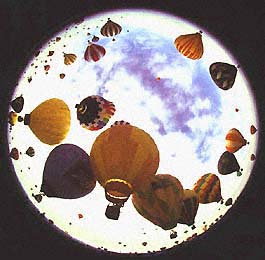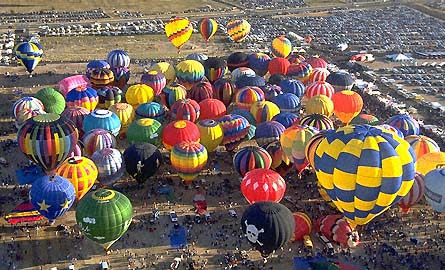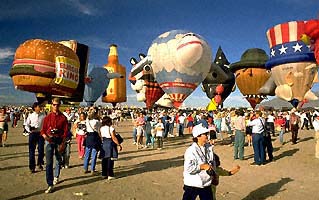





 |
My interest in ballooning was sparked by the
sight of two dozen hot air balloons flying over the Opening Ceremonies of the 1980 Winter Olympic Games in Lake Placid, NY. One of the pilots invited me to visit Albuquerque - his home and the site of the Albuquerque International Balloon Fiesta. Sid Cutter was that pilot - the founder of the
|
| The Albuquerque Fiesta
is the largest and one of the oldest balloon events in the world. The 27th 1998 edition featured over 800 balloons from all over the globe. I have participated on 16 occasions as both a pilot and member of the media. Attendance now tops one million for this annual October classic, the most photographed event in North America. |
 |
 |
Over the years the organizers have added
a number of events that have become very popular with the public. The "Special Shapes Rodeo' delights children and adults alike, featuring balloons in all shapes and sizes, from flying hamburgers & hot dogs to pigs, penguins and polar bears. Spectators are spellbound as these limp piles of fabric are inflated and slowly come to life. Who says cows can't fly! |
Indeed, cows do fly! - And that's
not all! I received a call from a
visiting pilot requesting my help
in arranging a crew for an unusual
balloon. This flying condom made
its international debut in Montreal
at an AIDS conference. It was the
subject of much attention. Special
shape balloons have become very
popular symbols for corporate
advertising: Famous Footwear
has a giant "Flying Sneaker" and
Planters has its "Mr.Peanut".
My first balloon was a 90,000 cubic ft. Thunder & Colt
built in England. From 1986 to 1991, I operated the
Minolta corporate balloon, flying 6 months each year
at balloon events across Canada, throughout the United
States and in Australia. Over the course of the program
an estimated 22 million people saw the balloon at various
events. I carried over 1000 passengers on over 400 flights.I have organized 4 international balloon events:
1983 * America's Cup Yacht Race Balloon Rally in
Newport, RI
1984 * St-Jean-sur-Richelieu Balloon Festival and the
CAN-AM Challenge Cup near Montreal.
1985 - "Destination Canada" International Balloon
Competition in Ottawa, Canada.
1986 - Inter-Provincial Balloon Race between pilots from
Quebec & Ontario - Point Calumet, QC.
The "Festival des Montgolfieres" at
St-Jean-sur-Richelieu, hosted the 1991
World Championship with 40 countries
participating. Airborne every August for
9 days, It remains the premier event in
the Montreal area and is home to more
than 30 regional balloon pilots.Elsewhere in Quebec just across the
river from Ottawa, the Gatineau Balloon
Festival held on the Labor Day weekend,
hosts up to 200 balloons, Canada's
largest balloon festival.
This is the balloon that I currently fly. It's called "Un
Sourire du Ciel" which in English means "A Smile
in the Sky". I no longer fly a corporate balloon, but
when I did, it allowed me to travel to places that
have eluded me in the course of doing photo
assignments. I am indebted to all the volunteers
who acted as crew members in the many towns
and cities where I flew. They are the unsung heros
who help make ballooning a great fraternity.
This is the Richelieu Valley,
20 miles south of Montreal.
It's easy to see why it's my
favorite place to fly. Fed by
the waters of Lake Champlain,
the serene Richelieu River
meanders north to the mighty
Saint Lawrence, slicing a path
through Quebec farmland and
small towns, and framed by
Mount Saint Hilaire and Mount
Saint Bruno. Some of the
friendliest farmers in the world
welcome our landings.
Landings are where you find them. Balloons are
at the mercy of the wind; when the remaining fuel
is at 25%, it's time to land. Most landowners allow
balloons to land on their property.
They are rewarded for their good will with a glass
of champagne, a tradition dating back to the 18th
century. Sometimes the landing takes place in a
remote area far from any "facilities". My crew in New
Mexico has shown a great degree of resourcefulness.